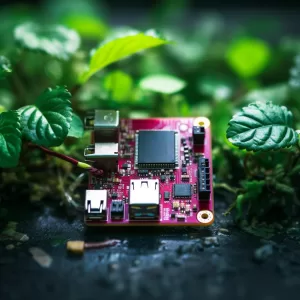
Which GSM and GPS Module Is Better for Raspberry Pi 3?
January 24 2024  1379
1379
Inquiry
Global electronic component supplier AMPHEO PTY LTD: Rich inventory for one-stop shopping. Inquire easily, and receive fast, customized solutions and quotes.
QUICK RFQ
ADD TO RFQ LIST
In this blog, we'll explore the capabilities of the Raspberry Pi 3, and discuss its compatibility with GSM and GPS modules.
What Is Raspberry Pi 3?

How Many Amps Does Raspberry Pi 3 Need?
It is recommended that the Raspberry Pi 3 be powered by a reliable supply of 5V and 2.5A. The Raspberry Pi may become unstable and may sustain damage if a lower amperage power supply is used. To guarantee dependable operation, it's critical to utilize a high-quality power supply.Can Raspberry Pi 3 Run 64 Bit?
Yes, the Raspberry Pi 3 can run a 64-bit operating system. Although the Raspberry Pi 3 comes with the official 32-bit Raspbian operating system, third-party 64-bit operating systems like Ubuntu and Gentoo are available. The 64-bit CPU architecture of the Raspberry Pi 3 can be utilized by 64-bit operating systems to enhance performance in specific applications.Video related to Raspberry Pi 3
How to Use Raspberry Pi 3?
To use a Raspberry Pi 3, you'll need a few things:- Raspberry Pi 3 board
- HDMI cable
- Monitor or TV
- Keyboard and mouse
- Power supply (5V micro USB)
- Internet connection (Wi-Fi or Ethernet)
- MicroSD card (with Raspbian or another operating system installed)
- Place the OS system-containing microSD card into the Raspberry Pi 3's slot.
- Attach the Raspberry Pi's HDMI wire to your TV or monitor.
- Turn on the Raspberry Pi by plugging in the power source.
- To configure the operating system, according to the on-screen directions.
- You can use the Raspberry Pi 3 just like any other computer after the setup is finished.
How to Power Raspberry Pi 3?
To power a Raspberry Pi 3, you will need a 5V micro USB power supply. Here's how to do it:- Find the Raspberry Pi 3 board's micro USB power port.
- Attach the Raspberry Pi 3's power port to one end of the micro USB cord.
- Connect the micro USB cable's other end to a power source, such as a computer's USB port or a wall adapter.
How to Install Raspbian Buster on Raspberry Pi 3?
To install Raspbian Buster on a Raspberry Pi 3, you can follow these steps:- Visit the official Raspberry Pi website to download the Raspbian Buster image.
- Flash the Raspbian image onto a microSD card using an application such as Etcher.
- Place the microSD card inside the Raspberry Pi 3.
- Turn on the Raspberry Pi 3, then finish the installation by following the directions on the screen.
What Is Raspberry Pi 3 Used For?
- Learning to program: Python, Scratch, and other programming languages can be learned using the Raspberry Pi 3.
- Home automation: Control smart home appliances like lights, thermostats, and security cameras with home automation.
- Media center: Kodi software may be used to transform a Raspberry Pi 3 into a media center, enabling you to stream and watch videos, listen to music, and more.
- Retro gaming console: The Raspberry Pi 3 can be used to play classic video games via emulators if it has the appropriate software and add-ons.
- Internet of Things (IoT) projects: To develop smart devices and sensors, the Raspberry Pi 3 is frequently utilized in IoT projects.
- Education: It's commonly used in classrooms to instruct students about programming, electronics, and computing.
- Server applications: A Raspberry Pi 3 can be used to run a low-power server for purposes like file servers, hosting websites, and Minecraft servers.
Choosing GSM and GPS Modules for Raspberry Pi 3
Various modules on the market can be used to give the Raspberry Pi 3 GSM and GPS functionality. With the help of these modules, the Raspberry Pi 3 can locate itself and connect over cellular networks, which opens up a world of possibilities for the Internet of Things, tracking, and remote monitoring applications. GSM Modules for Raspberry Pi 3 With the help of GSM (Global System for Mobile Communications) modules, the Raspberry Pi 3 may use cellular networks to send and receive SMS messages, make phone calls, and access the internet. Considerations including form factor, simplicity of integration, and available frequency bands should be taken into account while selecting a GSM module for the Raspberry Pi 3. Some popular GSM modules compatible with the Raspberry Pi 3 include:- SIM800C: A small GSM module that can be deployed globally, supporting quad-band GSM/GPRS frequencies.
- SIM900A: An inexpensive dual-band GSM/GPRS module that is perfect for basic cellular access, supporting GSM and GPRS frequencies.
- NEO-6M: A popular GPS module that is good for real-time tracking applications due to its high sensitivity and quick time to first fix.
- Ublox M8N: A multi-satellite constellation-capable high-precision GPS module that provides a precise location for demanding applications.
Conclusion
In conclusion, the Raspberry Pi 3 is a strong and adaptable platform with a variety of uses, and the addition of GSM and GPS modules to its repertoire of features only increases its potential. The correct GSM and GPS modules must be chosen for your Raspberry Pi 3 project to achieve dependable performance and easy integration, regardless of whether you want to add location tracking or cellular connectivity. You may choose the GSM and GPS modules that best fit the needs of your project by being aware of the characteristics and factors to consider.Populer Posts
AT40K40AL-1BGC
Microchip Technology
5SGXMB6R3F40C3G
Intel
EP4SGX290FH29I3N
Intel
EP2AGX45DF25C4
Intel
T8F49C2
Efinix, Inc.
5SGSMD5K3F40C4G
Intel
1SG280HH1F55E2VGS3
Intel
EP2C15AF256C8N
Intel
1SG250HN1F43I2LG
Intel
AGL250V2-CSG196
Microchip Technology
10CL080YF780C6G
Intel
